How to control worm casts
Related Articles
Earthworms can and do benefit golf courses but excessive casting can have a detrimental effect on fine turf surfaces. Here, Dr John Dempsey PhD reviews the scientific data on available casting controls at a time when most chemical treatments are no longer legal.
Worm castings are causing significant problems for the majority of sportsturf managers throughout the UK and Ireland, with chemical controls no longer available, what means of control do greenkeepers and sportsturf managers have? This topic was the subject of a seminar at BTME in Harrogate in January 2019. In this article we mention the benefits of earthworm populations but also highlight the detrimental effect excessive casting can have on fine turf surfaces. We will explore the earthworm biology and importantly, review the scientific data on available casting controls.
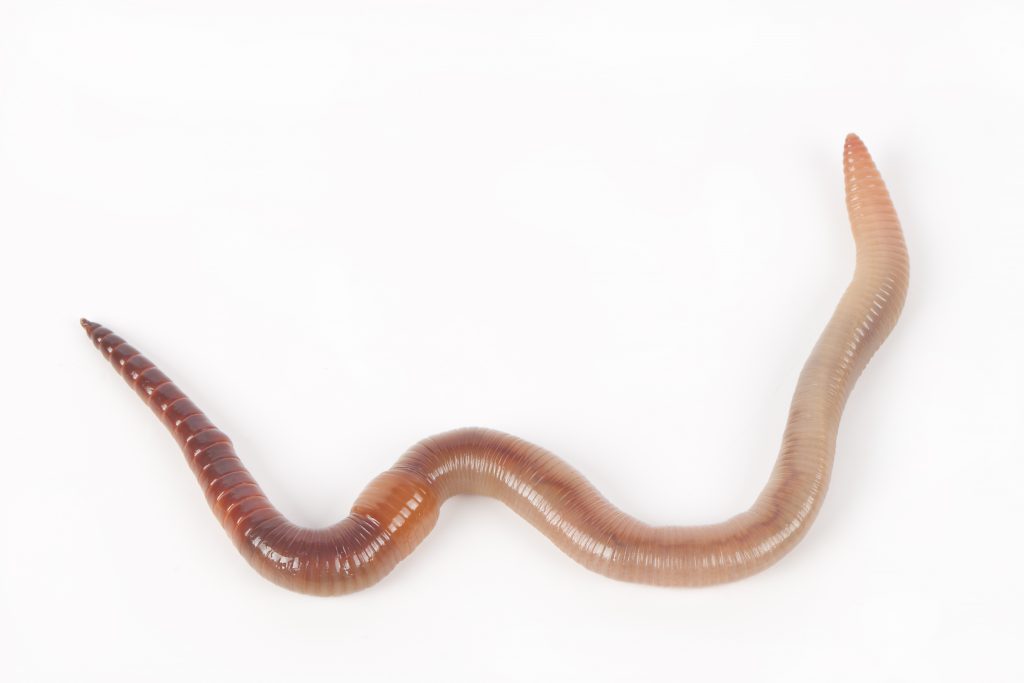
Earthworms are a vital component of the natural ecosystem, they can modify soil properties via their burrowing, incorporation and breakdown of organic matter, and mixing of soils, they also create pores within the soils allowing for improved water percolation and increased aeration. Because of this, they are viewed as beneficial in most agricultural and managed systems.
There are 26 species of Earthworm found in the UK:
- 18 species are non-casting
- Eight species are casting which can create problems in managed amenity and fine turf areas
- Life span depending on species can vary between four and eight years
- The main casting species are the lob worm (lumbricus terrestris), black headed worm (aporrectodea longa) and grey worm (aporrectodea calignosa).
The lob worm lives in vertical burrows up to three metres deep and feeds on fallen leaves and decaying organic matter, with a population of approximately 20 to 40 per metre squarred.
The black headed worm lives in open alkaline grassland and cultivated soil and has a size of 12 cm long. It feeds on soil and its population is approximately five to 20 per metre squared.
The grey earthworm feeds on soil in mainly arable and pasture lands.
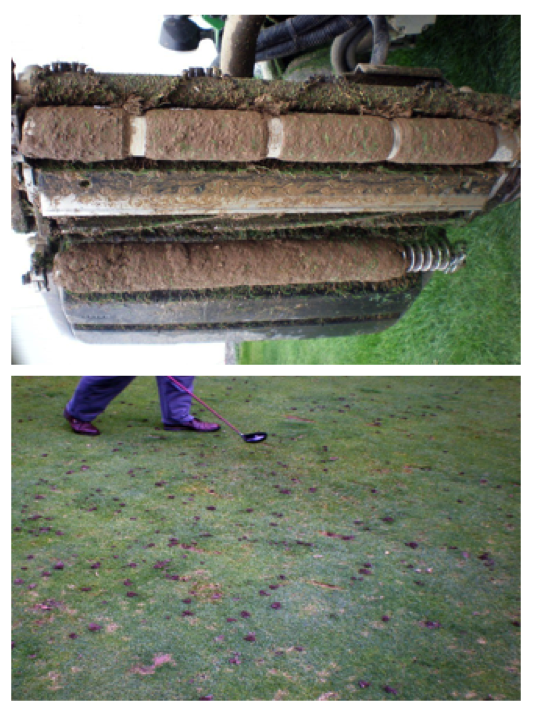
The effect of excessive worm casting on maintenance machinery and fine turf surfaces
Ecological functions of earthworms
Earthworms have many important ecological functions. In soils these include residue mixing, organic matter decomposition and nutrient recycling. Their burrowing activities allow for increased aeration and drainage, and nutrient and chemical movement through the soil profiles. Their casting helps with soil structure and fertility and, of course, worms are a food source for many birds and predators. As an example of the importance of earthworms in soil ecosystems, in the Netherlands, soils reclaimed from the sea at first did not have any earthworms. In these soils, the formation of topsoil with reasonable organic matter content did not take place, resulting in poor crop growth. Following a programme which introduced earthworms into these reclaimed soils, a dark topsoil layer was formed, and crop growth increased significantly.
Earthworms have two primary requirements: moist soil and an organic-matter food source. Supplies of both are plentiful on the average golf course. Consequently, earthworms often populate greens, tees and fairways. The benefits of earthworms in turfgrass systems cannot be ignored either. Low populations can lead to thatch accumulation, slow organic matter decomposition and nutrient recycling, soil compaction and reduced water infiltration.
However, in amenity turfgrass systems, excessive surface worm casting negatively impacts many important areas of successful turfgrass management, these include: reduced surface playability, increased weed and disease ingression, reduced mower efficiency and a negative impact on the overall aesthetic appearance of the sports surfaces.
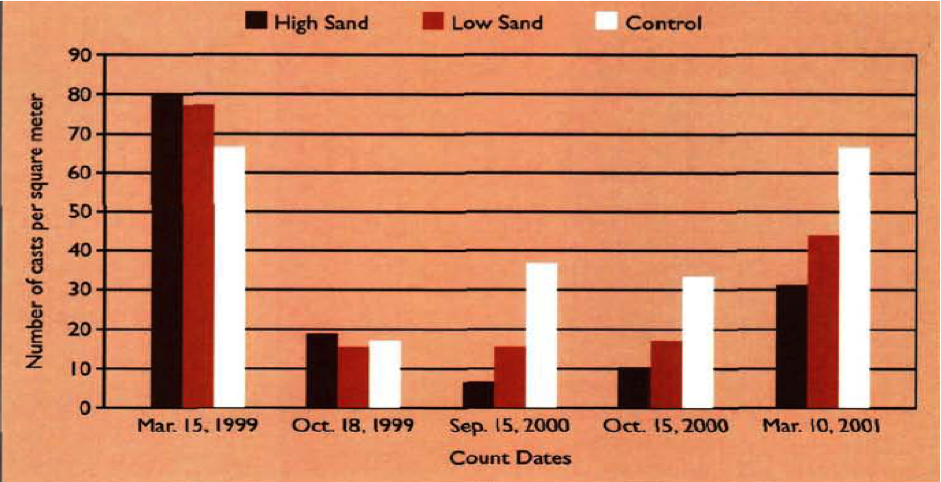
The effect of sand topdressing, applied over two years, on worm cast suppression
Worm control in the past
Until recently, surface casting was controlled to some extent by the use of a number of chemical options, these option have been withdrawn leaving turf managers searching for viable alternative control strategies.
Earthworm control in the past, that is from the early 1900s, firstly relied on Mowrah Meal, derived from the seeds of Bassia latifolia, which, when watered into the soil, irritated the earthworms, causing them to come to the surface where they were physically removed. From the 1950s, controls involved a number of highly toxic chemicals, which although highly effective in controlling surface casting, were extremely hazardous to the environment and humans. These included: copper sulphate, potassium permanganate, derris dust (an extremely poisonous chemical to invertebrates), lead arsenate, and mercuric chloride (extremely poisonous to humans and to other mammals).
In the more recent past: chlordane (organochlorine), was used from the 1960s to the early 1980s – very persistent in the soil lasting up to seven years or more in certain soil types such as heavy clay based soils, carbaryl and thiophanate methyl. Carbendazim, which was primarily sold as a fungicide, targeted casting species only, results were variable but it was the mainstay for cast suppression and remained in use until recently. It was the withdrawal of carbaryl that caused the current widespread concern among turfmanagers.
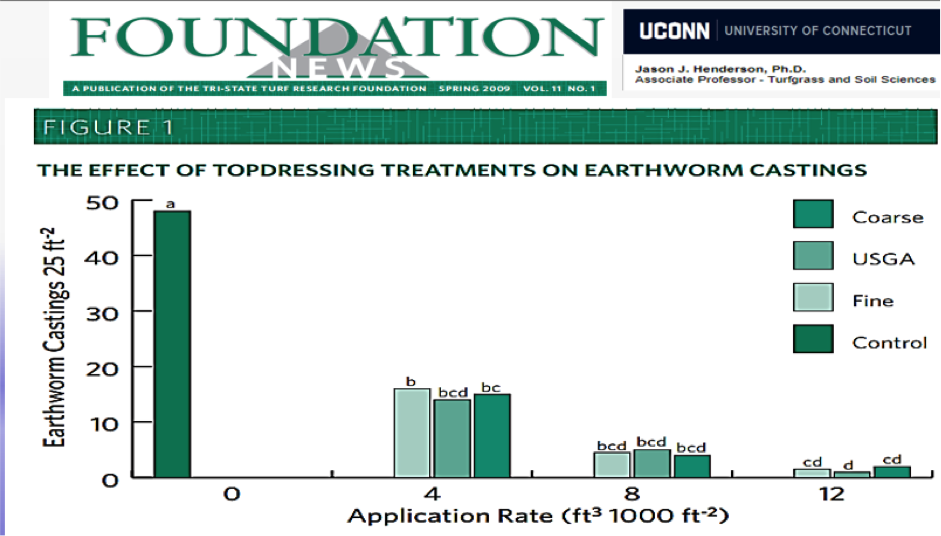
Research from University of Connecticut showing the effect of sand topdressing on worm cast suppression
What controls are available and are they effective?
A number of controls have over the past few years been suggested and been researched. Cultural controls have been studied as a means to suppress castings, these include grass clipping removal to reduce organic matter, thus reducing earthworms’ food sources, acidifying fertilisers and topdressing with angular sands or abrasive aggregates.
Other methods which may have efficacy are the use ‘soil conditioners’. As mentioned, the first successful means of cast control involved Mowrah Meal as an expellent, the active ingredient of this is a compound called saponin and recent research has provided results showing positive cast suppression leading to a number of products becoming available to turf managers.
There have been a number of studies into the removal of turfgrass clippings as a casting control, but these have to date provided no positive results. One such study, from Penn State University, looked at the effect of organic matter reduction and concluded this had no effect on casting volumes. A second study, conducted over two years to evaluate clipping removal and hollow-core aeration as methods to reduce casting, concluded that both these procedures had no effect on casting reduction.
The Penn State study also included the effects of ferrous sulphate as a surface acidifier, sand topdressing and saponins. Preliminary results show that saponins produced best results, with no effect on castings from sand topdressing, in fact they observed increased casting after topdressing.
Rutgers University researchers have also studied methods to reduce casting. They looked at a range of options:
- Three categories of fertilisers.
- Liming.
- Sand topdressing.
- Elemental sulphur applications.
- Sand topdressing combined with sulphur applications.
They concluded that fertiliser effects were not evident until the third season of the trial, when organic fertilisers doubled the number of castings, while the synthetic fertilisers had little effect.
Lime applications were deemed to have little to no effect on casting activity.
Sand topdressing has been promoted for a number of years as a means to reduce surface casting, it is surmised that the abrasiveness of sand particles and their susceptibility to drought influences both species composition and earthworm numbers in the soil. However, research has produced contradictory results. This study from Rutgers found that topdressing had a notable impact, but only on courses where casting activity was already high, with casting being reduced by 50 per cent after three seasons at some golf courses.
Paige Boyle is a presidential doctoral research fellow at Utah State University, studying turfgrass ecology. Her research into earthworm ecology and casting on fine turf surfaces concluded that, short term, sand topdressing made the casting problem worse, where past studies showed topdressing reduced casting. This appears to be the case in that a sustained topdressing programme is required for results to be positive. Research into the efficacy of the topdressing effect on casting from 1999 in the US and Canada indicates that topdressing requires a long-term commitment, and multiple applications are necessary in order to have a significant impact. A similar result was concluded by researchers at University of Connecticut in 2009, where sand topdressing produced significant reductions in casting, interestingly the texture of the sand particles had no impact on these results.
Surface acidification helps in reducing worm cast activity by reducing soil pH … or does it? Surface acidification requires the application of compounds such as sulphate of ammonia, ferrous sulphate and sulphur. The Rutgers study mentioned above produced interesting and relevant results in this area. They concluded that elemental sulphur applications had the most rapid and dramatic effect, reducing earthworm casting within the first season of application by as much as 97 per cent, compared to untreated plots. The potential to scorch turf was a concern with applications of elemental sulphur. Researchers initiated trials to identify the maximum rate that can be applied without risk to the turf rates of 146 kg/ha elemental sulphur (90 per cent) in a single application during spring or late summer without damaging fairway turf. They found the combination of sand topdressing and elemental sulphur was the most effective treatment in their trials.
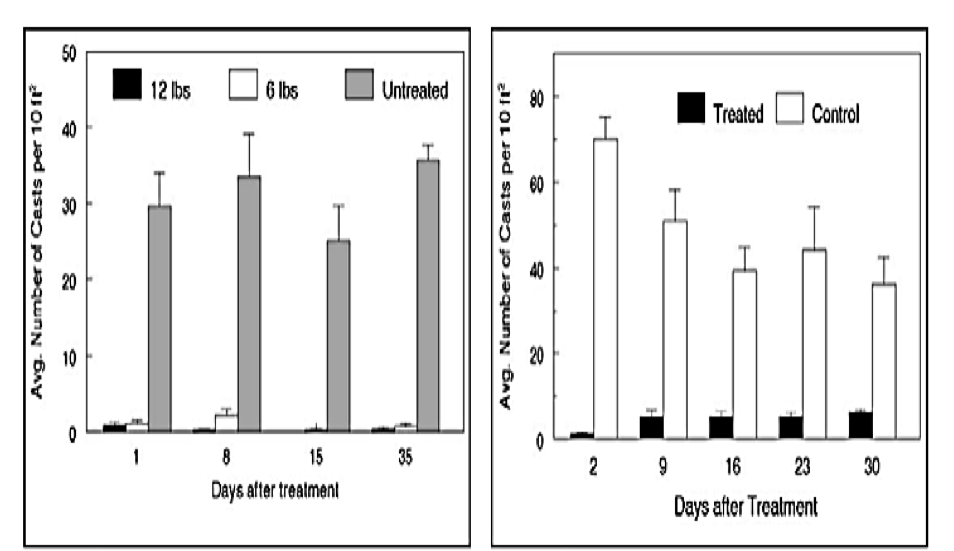
Left, reduction in earthworm casting on a creeping bent green, following treatment with saponin. Right, reduction in earthworm casting on a perennial rye fairway, following treatment with saponin.
Soil conditioners (saponins)
Mowrah Meal applied as expellents was successful in the past as it acted as an irritant to the earthworms, saponin compounds sourced from tea seed meal were the active component in this process. Natural saponin compounds are thought to disrupt the mucous coatings on earthworms, causing desiccation and death. Mowrah Meal is no longer commercially available, but earthworm-expelling fertilisers containing saponins derived from tea seed meal (a by-product of tea oil manufacture) are currently marketed for use on turf in a number of countries, including the UK and Ireland. There is some data supporting the suppression of casting following saponin treatments. Research carried out at the University of Kentucky determined a single tea seed meal application reduced castings in replicated plots by more than 95 per cent for at least five weeks. In a second trial at the same site, tea seed application reduced casts by 98 per cent after two days, and 83 per cent after 30 days. A sequence of laboratory trials confirmed that the chemical basis for tea seed meal’s activity on earthworms is the natural triterpene saponins found in tea seeds.
Expellents such as saponins may not necessarily work on all earthworm species, aporrectodea and lumbricus spp are susceptible but amynthas spp less so. Saponin treatments need to be well watered into the soil profile and repeated before each peak of casting activity because they have little or no residual activity. Also, earthworms hatching from cocoons are not affected and may repopulate the site over time.
Conclusions
Earthworms are an important component of ecosystems – vital for healthy soils!
They have beneficial effects on soil structure, organic matter recycling and provide food sources for many species.
Of the 26 species of earthworm found in the UK, three of these – the lob worm, black headed worm and grey worm can cause significant disruption to fine turf surfaces reducing surface playability, increasing weed and disease ingression, reducing mower efficiency and negatively impacting the aesthetic appearance of sports surfaces.
With the withdrawal of all chemical controls a number of other options have been explored with a view to cast suppression. These include reduction of organic matter, sand topdressing, surface acidification and the use of saponins. Of these, long term sand topdressing combined with surface acidification with sulphur appears effective. The use of saponin-based products also appears to effectively suppress castings, but these treatments need to be applied frequently during peak activity.
The seminar ‘Disease suppression without fungicides – can it be done?’ was presented during Continue to Learn, at BTME 2019.
Dr John Dempsey, PhD BSc (Hons), was course manager at Royal Curragh Golf Club, Ireland’s oldest golf club, from 1993 to 2019. He has a first class honours degree in turfgrass science from Myerscough College and a PhD in turfgrass pathology at the University of the West of England’s Centre for Research in Biosciences. He is also a member of Greenkeeping’s editorial advisory panel

























